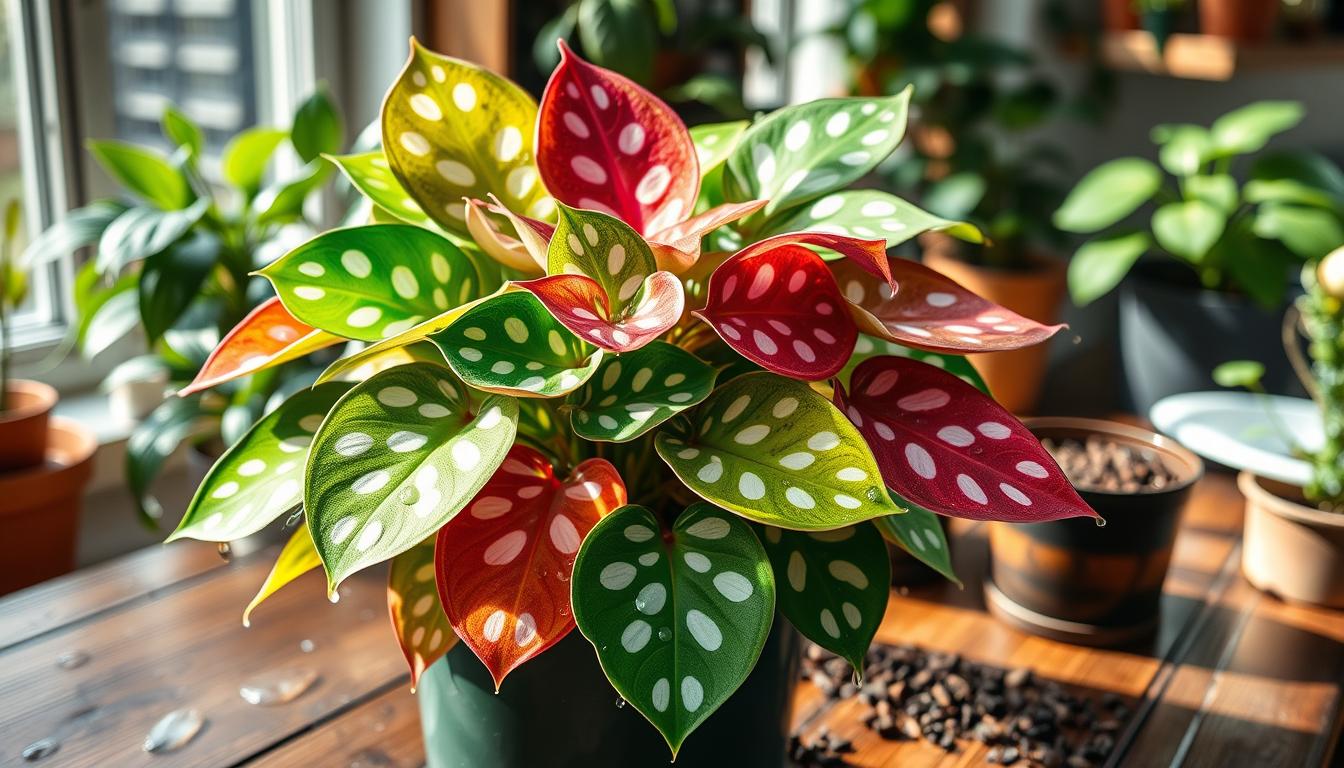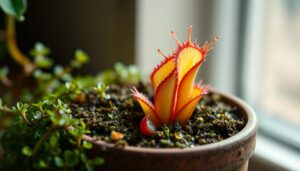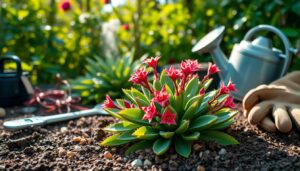Polka Dot Plants need the right care to thrive. Knowing how to care for them is key. With over 100 varieties, you can pick the best one for your space.
Start by learning the basics of Polka Dot Plant care. This will help your plant grow well.
Polka Dot Plants are colorful and easy to care for. They’re perfect for indoor gardens. With the right care, you can enjoy their beauty at home.
Whether you’re new to plants or not, learning about Polka Dot Plant care is important. It helps keep your plant happy and healthy.
Introduction to Polka Dot Plants
Exploring Polka Dot Plants reveals their special traits and types. These plants have leaves that are bright and colorful. They come in many colors like green with pink spots, purple, white, or red.
These plants can grow up to 1 to 2 feet tall and wide. They love bright, indirect light and need moderate watering. Knowing they prefer slightly acidic soil helps keep them healthy.
Polka Dot Plants thrive in USDA hardiness zones 10-11. They need temperatures above 50°F to survive. Growth starts at 60°F or higher.
With the right care, Polka Dot Plants can brighten your indoor garden. Learning about their unique traits helps you care for them well. This way, they can reach their full beauty.
| Characteristics | Description |
|---|---|
| Mature Size | 1 to 2 feet tall and wide |
| USDA Hardiness Zones | 10-11 |
| Soil pH Preference | Slightly acidic at 5.8 to 6.2 |
Ideal Growing Conditions for Polka Dot Plants
To keep your Polka Dot Plant happy, mimic its natural home. These plants grow on Madagascar’s rainforest floor. They love shade from big trees and plants.
They thrive in warm places, between 65°F and 75°F. This is perfect for indoor plants if you keep the temperature steady. Place them near an east- or west-facing window for the best light.
Best Lighting for Your Plant
Polka Dot Plants can handle different lights. But, they love partial shade. Use a sheer curtain to filter direct sunlight and prevent leaf burn.
Optimal Temperature Ranges
Temperature is key for your plant’s health. Keep it between 65°F and 75°F. Don’t put it near vents, fireplaces, or drafty windows.
With the right light and temperature, your plant will grow well. Water and fertilize it often. Prune it to keep it looking good and growing new leaves.
| Factor | Ideal Condition |
|---|---|
| Lighting | Partial shade |
| Temperature | 65°F – 75°F |
| Humidity | 50% or higher |
Watering Your Polka Dot Plant
Watering your Polka Dot Plant right is key. You need to keep the soil moist but not too wet. To check, stick your finger into the soil about 1 inch deep.
If it’s dry, it’s time to water. If it’s already moist, wait a bit longer before checking again.
Watering too much can harm your plant. It might get yellow leaves, soggy soil, and smell bad. Not enough water can make leaves droop and soil dry out.
To avoid these problems, water when the top inch of soil feels dry.
Here are some tips to remember:
- Water your Polka Dot Plant once or twice a week in spring and summer.
- Water less in winter because it needs less moisture.
- Make sure your pot has holes to let water out and prevent root rot.
By following these tips and watching for signs of too much water, your plant will stay healthy. Adjust your watering based on how your plant reacts. And don’t worry if you have more questions.
| Season | Watering Frequency |
|---|---|
| Spring/Summer | Once or twice a week |
| Winter | Reduced frequency |
Soil Requirements for Polka Dot Plants
Choosing the right Polka Dot Plant soil is key for your plant’s health. The best soil for Polka Dot Plant is rich in organic matter. It should drain well and be slightly acidic, with a pH of 5.8 to 6.2.
For the best results, use an all-purpose organic potting mix. Add pumice or perlite to improve soil drainage for Polka Dot Plant. This stops waterlogged soil and root rot, helping your plant grow well.
- High organic matter content
- Good water-holding capacity
- Excellent drainage to prevent waterlogging
By picking the right Polka Dot Plant soil and following care tips, you’ll create a great home for your plant. It will grow and thrive.
Fertilizing Your Polka Dot Plant
To keep your Polka Dot Plant happy and thriving, fertilization is key. When it comes to Polka Dot Plant fertilization, timing is everything. During the growing season, which is spring to fall, fertilize your plant once a month. This gives it the nutrients it needs for healthy growth and bright colors.
For the best fertilizer for Polka Dot Plant, choose a balanced, water-soluble fertilizer. A 20-20-20 (nitrogen-phosphorus-potassium) ratio is best. Organic fertilizers are also good because they release nutrients slowly and won’t hurt your plant’s roots. Remember, these plants need regular fertilization to stay colorful and grow well.
- Fertilize your Polka Dot Plant during the growing season (spring to fall) for optimal results.
- Use a balanced, water-soluble fertilizer with a ratio of 20-20-20 (nitrogen-phosphorus-potassium).
- Consider using organic fertilizers, which release nutrients slowly and are less likely to burn your plant’s roots.
By following these guidelines and using the right best fertilizer for Polka Dot Plant, you’ll help your plant grow well. Remember to fertilize your Polka Dot Plant regularly. If you have more questions about Polka Dot Plant fertilization or when to fertilize Polka Dot Plant, don’t hesitate to ask.
Pruning and Maintenance
Pruning and maintenance are key for your Polka Dot Plant’s health and look. Prune in the spring after it wakes up. This helps it grow bushy and strong.
Use sharp scissors or shears to cut. This stops diseases. Remove dead parts and shape the plant. Pinch off top leaves weekly for more growth.
Managing pests is also important. Watch for mealybugs and scale insects. Treat them fast. Water and fertilize well to keep pests away.
Here are some tips for keeping your Polka Dot Plant healthy:
- Water consistently, allowing the soil to dry slightly between waterings
- Fertilize regularly, using a balanced fertilizer during the growing season
- Provide bright, indirect light, and maintain a humid environment
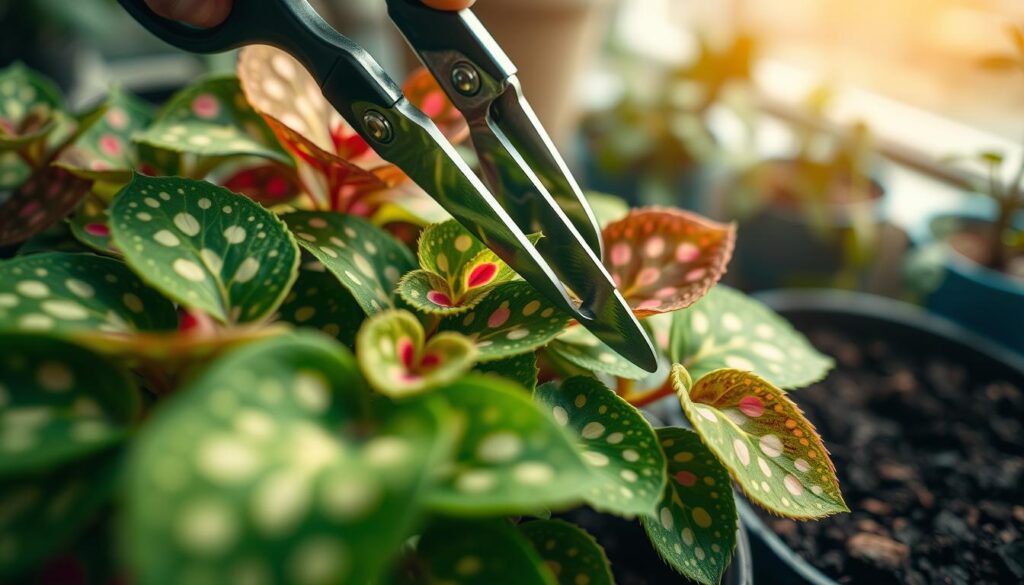
Follow these tips to keep your Polka Dot Plant happy. Watch your plant and change care as needed. This will help it thrive.
| Task | Frequency |
|---|---|
| Watering | Weekly |
| Fertilizing | Every 4-6 weeks |
| Pruning | Spring, after dormant period |
Propagating Your Polka Dot Plant
There are two ways to Polka Dot Plant propagation: water and soil. Your choice depends on what you like and what you have. If you want to learn how to propagate Polka Dot Plant, starting with water is easy and fun.
To start Polka Dot Plant propagation, cut stems about 10cm long. Make sure to cut below the nodes for better root growth. For soil, use a mix that drains well in a small pot. Keep the soil wet by misting it every other day. Adding rooting hormone can help your plants grow.
Remember these tips for success:
- Cleanliness: Use clean scissors or shears to prevent infections.
- Humidity: Keep the area humid, especially when using soil.
- Light: Give them enough light but not too much direct sunlight.
By following these steps and tips, you can grow more Polka Dot Plants. Enjoy these beautiful plants in your home.
| Propagation Method | Advantages | Considerations |
|---|---|---|
| Water | Visibility, ease | Algae buildup, need for clear containers |
| Soil | Higher success rate for some, less maintenance | Less visibility, potential for overwatering |
Common Problems and Solutions
If you have a Polka Dot Plant, you might face some common issues. One big problem is when the leaves turn color. This can happen if your plant gets too much or too little sun. To fix this, give your plant light that’s not too bright but not too dim either.
Another issue is pests like spider mites, scale, and aphids. These bugs can make your plant’s leaves turn color if not stopped. Check your plant often and use insecticidal soap or neem oil to fight pests.
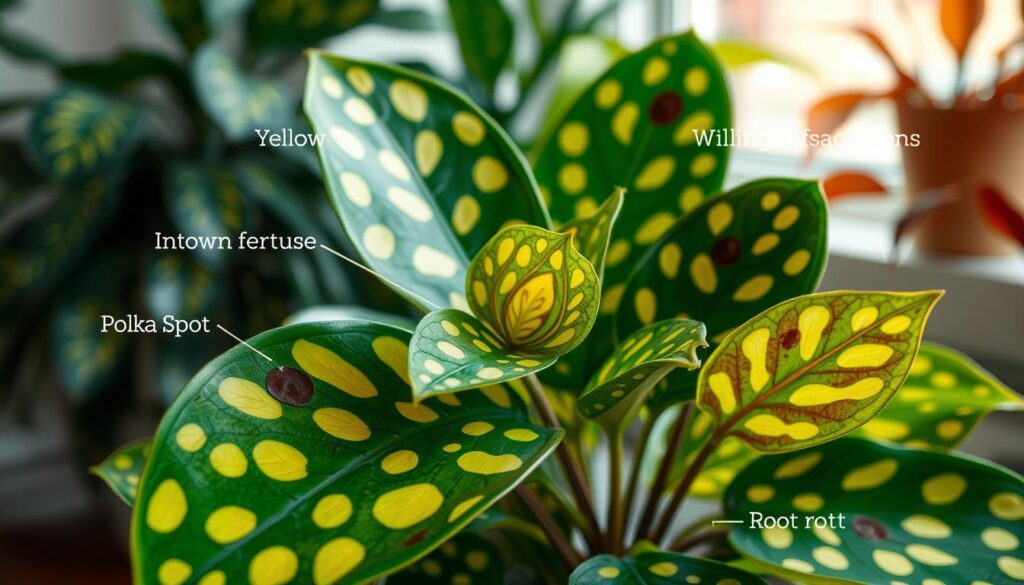
- Too much water can make leaves turn yellow and cause root rot
- Not enough water can make leaves look limp
- Changes in temperature can slow down your plant’s growth
To solve these problems, water your plant right. Keep the soil moist but not soggy. Also, keep the temperature steady between 65-75°F (18-24°C). Fertilize your plant with a balanced food regularly.
Knowing about these problems and how to stop them can help your Polka Dot Plant stay healthy. Check your plant often. This way, you can catch problems early and keep your plant happy.
Conclusion and Final Tips for Happy Polka Dot Plants
With the right care, your Polka Dot Plant can thrive. It will add vibrant color to your indoor space. Here are the key Polka Dot Plant care tips to keep your plant happy and healthy:
Recap of Key Care Tips
Give your Polka Dot Plant the right light. It needs bright, indirect light. Keep the soil moist but not too wet.
Keep the air around your plant high humidity. Use a potting mix that drains well and is rich in nutrients. Prune and fertilize regularly to help your Polka Dot Plant grow well.
Encouragement for Plant Enthusiasts
With a little patience and care, your Polka Dot Plant will thrive. These plants add beauty to your home and clean the air. They are great for any Polka Dot Plant enthusiast.
Enjoy the joy of caring for your Polka Dot Plant. Watch it become a lush, vibrant part of your indoor oasis.
MORE RESOURCES:
For more plant ideas for plants the flourish in humid environments check out are listicle article on 10 Beautiful Plants the thrive in humid environments HERE!
If you would like to see more about other large stunning statement plants that can be a beautiful anchor plant for your indoor garden check out our article of 10 Stunning Large Indoor Plants HERE!
If you want to find other great houseplants to develop your indoor garden check out our list of 100 great houseplants that can help you begin to develop your indoor garden strategy at our Ultimate Guide To Houseplants.


